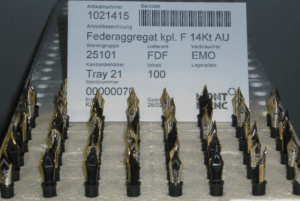By Andreas Kemmner and others.
The nibs in the expensive Montblanc pens are genuinely handmade. However, production processes must also be optimized and made fit for the future in the noble manufactory. A team of experts reduced throughput times as well as stocks and adjusted the material flow.
Montblanc stands for quality and luxury. The company also wants to be at the forefront of processes. Following the introduction of electronic planning boards around two years ago, which made production control at Goldfedermanufaktur efficient, transparent and clear, the next major challenge was now on the agenda: the reorganization of production with the aim of significantly reducing throughput times and work in progress.
In order to achieve this goal
- the material flow and department layout were completely redesigned and rebuilt,
- production is reorganized into production segments (production blocks) and
- production control was expanded to include a Heijunka component for leveling and smoothing daily capacity requirements in relation to fluctuations in incoming orders.
The spring unit production process is very complex. It resembles a factory with flow production. These spring units are manufactured exclusively by hand. The production process consists of up to 35 different steps. The high number of variants and the daily changing bottlenecks in production due to demand are now mastered quickly and efficiently using electronic planning boards. This was a basic prerequisite for the reorganization of the gold spring manufactory to reduce throughput times and inventories.
Material flow optimization and layout planning in detail
In recent years, Montblanc’s growing departmental structures and new investments had meant that the flow of materials in the department no longer met the requirements for uniform material flows. The challenge was to optimize the material flow of the three production groups within the existing, relatively cramped premises. should be achieved:
- uniform material flows and loss-free processes,
- Shortened material transport routes,
- increased transparency,
- reduced space requirements and
- support for the desired production segmentation (production blocks).

Furthermore, a number of additional constraints had to be taken into account, such as the expansion of the laser technology competence center and the consolidation of all hydraulic presses in a closed room (noise reduction). As a result, all requirements, including the additional boundary conditions, were met. The new layout is much “tidier” and has also created additional free space.
The actual material flow in the three production groups was designed and implemented in a so-called U-layout. However, the initially favored approach could not be realized in the existing Montblanc premises. When checking its feasibility in the layout planning, it quickly became apparent that the width of this layout was too large to integrate all three production groups into the existing space. A material flow in a U layout with a central material supply rail was therefore chosen. This solution requires considerably less space than a “classic” U-layout approach. The material flow in the new U-layout begins in Montblanc production at the welding workstation with the welding of an iridium ball. After the production order has been processed at other workstations, the material leaves the department for the first time after the presetting operation. The springs are tumbled (deburred) in the vibratory grinding department. There are a total of three interfaces to external departments during the entire production process (vibratory finishing, rhodium plating, washing). A central “outgoing goods” collection point was created for these outgoing goods. It is centrally located in the immediate vicinity of all three production groups and can be reached quickly. This collection point is divided into three areas: Each external processing area has its own area from which the employees collect the material independently.
The new collection point: Montblanc incoming goods
After external processing, the material is transported from these departments back to the specially created staging areas (internal/external interface) in the gold spring factory (Fig. 2). These staging areas are located directly next to the subsequent work steps, making the material waiting for further processing immediately visible. The staging areas and the central material supply rail thus ensure maximum transparency in the production groups with regard to the material waiting to be processed. In addition to the last step, the so-called writing, in which Montblanc ink is used to test whether the nib glides “effortlessly” over the paper, only the polishing step was not integrated into the U layout. Integration would have forced a complete encapsulation of the system within the U-layout and thus “blown up” the U-layout. The central element in being able to significantly reduce throughput times and work in progress is the reorganization of Montblanc production into manufacturing segments. The new material flow and the new U-layout take this reorganization into account and support it. Compared to the previous, workshop-oriented production, the production in segments (production blocks) has drastically reduced both throughput times and work in progress. The ideal situation would be to organize the entire Montblanc production in a single segment. In line with this approach, the aim was to keep the number of segments as low as possible and the number of operations per segment as high as possible. During the Montblanc production process, the nib assemblies have to leave the gold nib factory several times for further processing in other departments. The segment limits were defined by this non-resolvable structure: They are always located where the spring units leave spring production (end of segment) or are fed back into spring production (start of segment). Between these “natural” segment boundaries, it was possible to create continuous flow production.

The new Montblanc production structure therefore has four internal and three external segments. A production order must run through all operations of a segment (internal or external) within one working day. The ideal lead time for a production order would therefore be 7 working days instead of the previous average of 33 working days. However, the target for the throughput time is 10 working days: Buffer stocks are required within the segments at sensitive workstations in order to avoid losing capacity at other workstations within the process chain due to machine downtime. Here, Montblanc clearly prioritizes employee utilization and productivity over throughput time and inventory reduction. The production segmentation clearly limits the circulating stocks in gold nib production. Each production segment only ever contains production orders in the amount of the daily capacity of the production group. The work in progress is therefore calculated from the net throughput time of all segments multiplied by the daily capacity per production group plus the buffer stocks. Compared to the previous circulating stocks, between 50 and 65% less material is now required in the process.
Thanks to the Heijunka method: leveling of incoming orders
The 14- and 18-carat Montblanc gold nibs wait in polystyrene trays to be used at the tip of the fountain pen in the final assembly of the writing instruments. However, before they get there, they have undergone a complex, multi-stage, time-consuming and labor-intensive production process. In view of the complexity of production, optimizing employee deployment (capacity utilization) while reducing throughput times and inventories posed a major challenge for production control at Goldfedermanufaktur. In order to level out and stabilize capacity utilization in gold nib production at Montblanc in the future, fluctuations in incoming orders (fluctuations in demand) must no longer spill over into the three production groups. To prevent this, the current production control system was expanded to include a Heijunka control system.
The term Heijunka refers to the process of smoothing required capacity requirements. Smoothed production is considered to be the most efficient and cost-effective method of production. The analyses of the incoming order data carried out at the start of the project showed very high fluctuations in the daily Montblanc incoming order quantities within the production groups, ranging from up to seven times the daily capacity limit to no incoming orders at all over several days. If an overall analysis was carried out across all three production groups, the periods with no incoming orders at all were significantly reduced. This made it clear that, in addition to leveling incoming orders and capacity utilization within the production groups, the Heijunka control system would essentially also have to be used for balancing between the production groups. Each Montblanc production group has its own Heijunka board (Fig. 3). This is populated with the daily incoming orders by production control. The basis for the daily assignment of production orders to the production groups from the Heijunka board is the weekly employee scheduling. It is used to determine the daily available capacity in the form of “number of employees” and “number of machinable spring units” per production group. The number of spring units that can be processed represents the cycle at which production order quantities must be loaded from the Heijunka board to the first work cycle groups each day.
Throughput times and work in progress documented daily
This “cycle” is now followed by the production groups from production segment to production segment. With a throughput time of one working day, the quantities are “clocked on” from segment to segment. The buffer stocks are taken into account. Each production group organizes the organization of work within the segments and the staffing of the corresponding workstations. The following aspects in particular must be taken into account in the management by the Montblanc production groups:
- Not every spring unit passes through the same workstations.
- Each work step has very different processing times in some cases.
- Only a few jobs can be filled at any one time, as the ratio of jobs to employees is approximately 3:1.
- Despite very high employee qualifications, not every employee can process all operations or all operations at the same speed.

Throughput times and work in progress are documented and historicized daily for each production group, each production segment and each individual workstation and evaluated in monthly reports. If there are no more orders on the Heijunka board or if the Heijunka board is overflowing with orders, leveling within the production group is no longer sufficient. If this is the case, a comparison must be made between the three production groups. Each Montblanc production group manufactures a different product range. This means that production orders cannot be exchanged at will.
There is only one product group that can be produced in all three production groups. This is a volume model with regular consumption behavior and thus facilitates balancing. Compensation is always necessary if incoming orders are so low that “lost” capacity must be expected in a group. In this case, orders of the volume model are transferred from the board of one production group to the other production group. However, it can also happen that a Heijunka board “overflows” due to a large number of incoming orders. If the order backlog exceeds five working days, production orders are transferred to the other groups.

